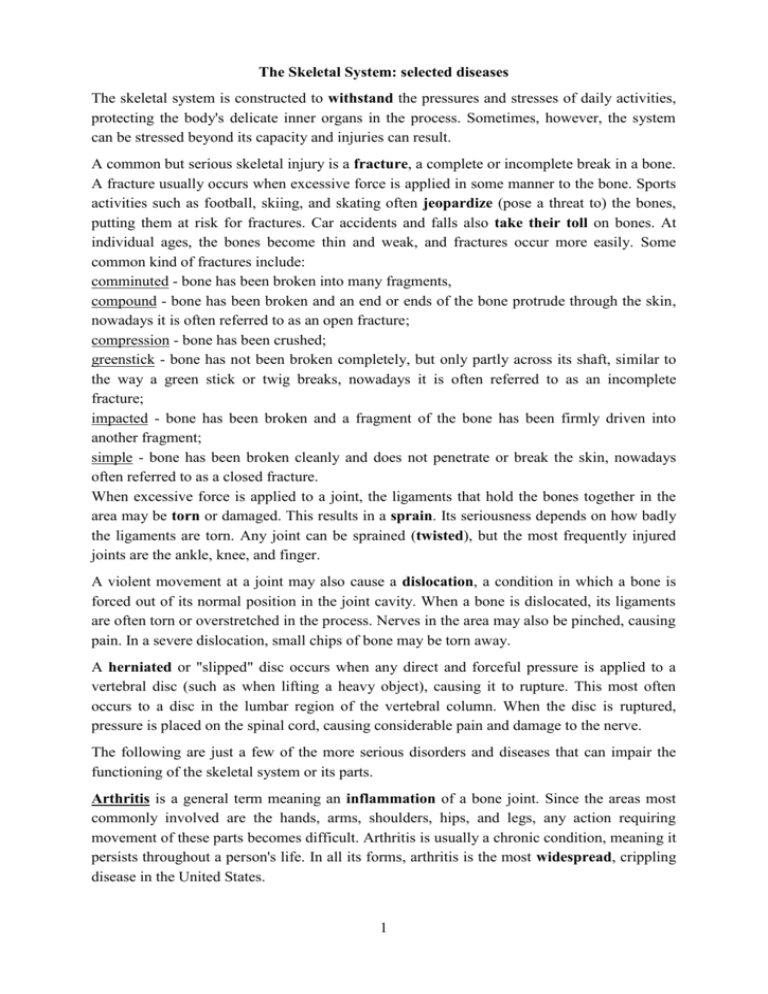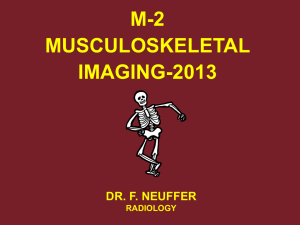The Skeletal System : what can go wrong * selected diseases
advertisement

The Skeletal System: selected diseases The skeletal system is constructed to withstand the pressures and stresses of daily activities, protecting the body's delicate inner organs in the process. Sometimes, however, the system can be stressed beyond its capacity and injuries can result. A common but serious skeletal injury is a fracture, a complete or incomplete break in a bone. A fracture usually occurs when excessive force is applied in some manner to the bone. Sports activities such as football, skiing, and skating often jeopardize (pose a threat to) the bones, putting them at risk for fractures. Car accidents and falls also take their toll on bones. At individual ages, the bones become thin and weak, and fractures occur more easily. Some common kind of fractures include: comminuted - bone has been broken into many fragments, compound - bone has been broken and an end or ends of the bone protrude through the skin, nowadays it is often referred to as an open fracture; compression - bone has been crushed; greenstick - bone has not been broken completely, but only partly across its shaft, similar to the way a green stick or twig breaks, nowadays it is often referred to as an incomplete fracture; impacted - bone has been broken and a fragment of the bone has been firmly driven into another fragment; simple - bone has been broken cleanly and does not penetrate or break the skin, nowadays often referred to as a closed fracture. When excessive force is applied to a joint, the ligaments that hold the bones together in the area may be torn or damaged. This results in a sprain. Its seriousness depends on how badly the ligaments are torn. Any joint can be sprained (twisted), but the most frequently injured joints are the ankle, knee, and finger. A violent movement at a joint may also cause a dislocation, a condition in which a bone is forced out of its normal position in the joint cavity. When a bone is dislocated, its ligaments are often torn or overstretched in the process. Nerves in the area may also be pinched, causing pain. In a severe dislocation, small chips of bone may be torn away. A herniated or "slipped" disc occurs when any direct and forceful pressure is applied to a vertebral disc (such as when lifting a heavy object), causing it to rupture. This most often occurs to a disc in the lumbar region of the vertebral column. When the disc is ruptured, pressure is placed on the spinal cord, causing considerable pain and damage to the nerve. The following are just a few of the more serious disorders and diseases that can impair the functioning of the skeletal system or its parts. Arthritis is a general term meaning an inflammation of a bone joint. Since the areas most commonly involved are the hands, arms, shoulders, hips, and legs, any action requiring movement of these parts becomes difficult. Arthritis is usually a chronic condition, meaning it persists throughout a person's life. In all its forms, arthritis is the most widespread, crippling disease in the United States. 1 Osteoarthritis occurs as a result of aging or injury. It is characterized by deterioration of the cartilage covering the bones in the joints of the body. It is most often seen in people who are forty years of age or older. Causes of osteoarthritis include wear and tear due to aging or overuse, injury, hereditary factors, and obesity. The wearing away of the cartilage results in the bones rubing against each other, causing among others the deep joint pain characteristic of this disease. The joints most commonly affected by osteoarthritis are those of the knees, hips, and fingers. Other areas can be affected by injury or overuse. The condition can cause minor stiffness and pain, or it can result in severe disability. Treatment of osteoarthritis includes the use of anti-inflammatory drugs such as aspirin to reduce pain and swelling; supportive devices such as a brace, walker, or crutches; massage; moist heat; and rest. Osteoporosis (which literally means "porous bones") occurs when a body's blood calcium level is low and calcium from bones is dissolved into the blood to maintain a proper balance. Over time, bone mass and bone strength decrease. As a result, bones become dotted with pores. Weak and fragile, they break easily. Even a sneeze or a sudden movement can cause a fracture in someone with severe osteoporosis. There is no cure for osteoporosis, but drugs are available that stop further bone loss and even help build new bone tissue. For some people, though, these drugs may not help build enough bone to replace that already lost in the body. The best way to prevent osteoporosis is to maintain a healthy lifestyle throughout one's life: adhering to a diet with the proper amounts of calcium and vitamin D, avoiding smoking and heavy alcohol drinking, and exercising regularly. Scoliosis is a sideways curvature of the spine or vertebral column. Normally, the spine has a set of front-to-back curves. When viewed from rear, a normal spine usually appears straight. A small degree of lateral (sideways) curvature in the spine does not cause any medical problems, but larger lateral curves can cause imbalance and lead to muscle fatigue and pain. More severe scoliosis can interfere with breathing and lead to arthritis of the spine. Treatment for scoliosis depends on the degree of curvature. If the curvature is moderate, a brace may be worn. Bracing cannot correct curvature, but may be effective in halting or slowing the progression of the curve. Surgery is often required if the curvature is severe, if the curve has progressed despite bracing, or if there is significant pain. During surgery, the spine is straightened as much as possible, then vertebrae are fused together to prevent further curvature. Spinal fusion leaves the involved area of the vertebral column permanently stiff. Spina bifida Spina bifida is the common name for a range of birth defects caused by problems with the early development of the vertebral column or spine. The main defect of spina bifida is an abnormal opening somewhere along the vertebral column due to a failure of the vertebrae to wrap completely around the spinal cord. This leaves the spinal cord unprotected and vulnerable to either injury or infection. Treatment for spinal bifida is aimed first at surgically closing the spinal defect to prevent infection. Further operations are often necessary to repair the hip dislocations, scoliosis, or other conditions. The success of treatments is still dependent on the severity of the original spinal defect. 2








